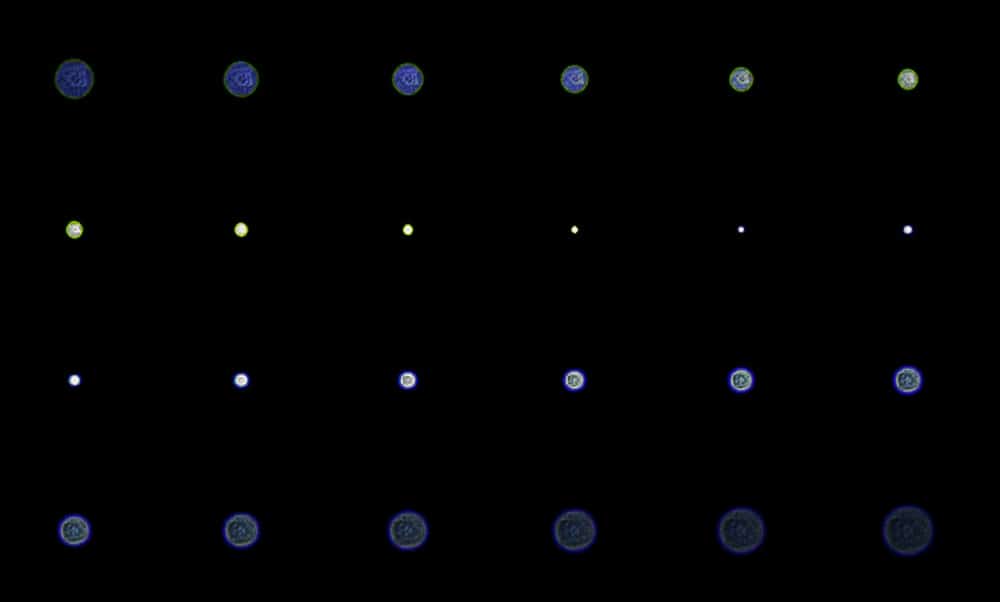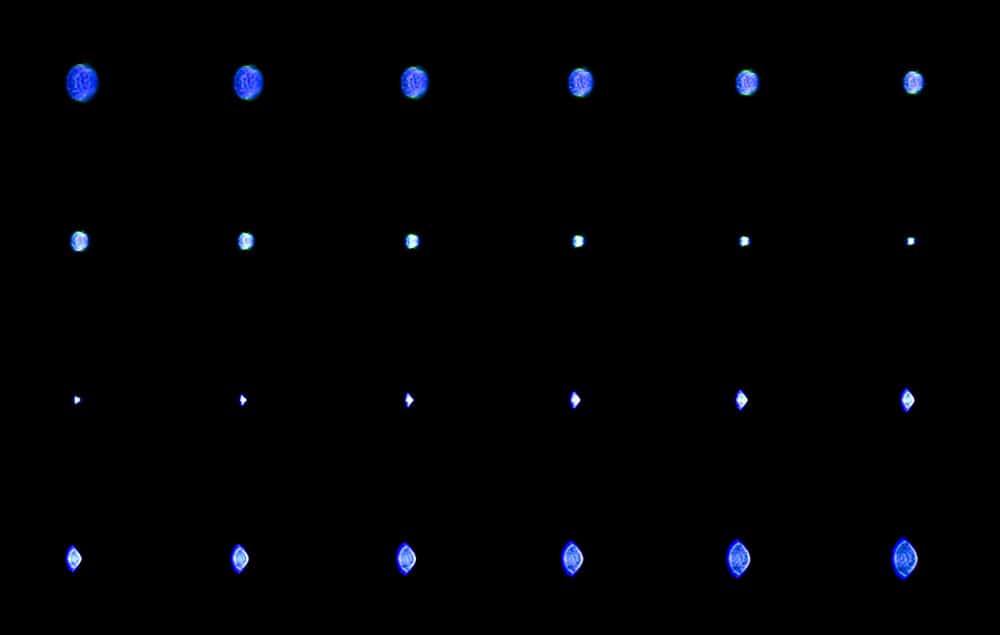This is one in a series of posts on the Nikon Z6 and Z7. You should be able to find all the posts about that camera in the Category List on the right sidebar, below the Articles widget. There’s a drop-down menu there that you can use to get to all the posts in this series; just look for “Nikon Z6/7”.
I have long published out-of-focus point spread functions (OOF PSFs) for lenses, since it’s a good way to learn the far-OOF bokeh characteristics of a lens. Here’s a set of OOF PSFs from the 50 mm f/1.8 Nikkor-S.
Marianne Oelund has taken that a step further, and looked at PSFs as the lens is progressively defocused. I thought I’d take a leaf from her book and give that a try with the Nikon 50S on a Z7. I used an Astrozap artificial star for the target, and the Z7’s focus shift shooting (FSS) feature for the focusing, with the star in the center of the field.
Here’s what I got:
The closest-focused image is the one at the upper left. Focusing is progressively moved further away in steps that move the image at the sensor by about 90 micrometers. Perfect focus is not achieved, but the next-to-last image in the second row is closest. White balance, exposure, and the raw processing was the same for all the images, and the darkening of the further OOF PSFs is what you’d expect since the same amount of light energy is being spread over a larger area.
What can we learn from these?
First off, there is a bright ring around the further-OOF images. We’ve seen that before. But now there’s an interesting asymmetry: the ring is more pronounced when the lens is back-focused than when it’s front-focused. It’s also a different color: When the lens is front-focused, it’s green, and when it’s back-focused, it’s bluish, but appears weaker. I suspect that the relative weakness is due to the characteristics of the human eye, which is much more sensitive to green light than blue light.
We can also see longitudinal chromatic aberration, with the close-but-no-cigar front-focused images green and the near back-focused ones blue.
Here’s what happens when you place the star off-axis, in this case almost all the way to the left-center edge of the frame:
Now the shape of the PSF is quite different when the lens is front-focused (top two rows) than when it is back-focused in the bottom two rows. There is not much coma for front-focusing and a comet-lookalike for the barely back-focused images. There is astigmatism that shows up in the orientation of the greenish parts of the periphery.
I’d like to perform the same sort of test with another lens. I think the Nikon 58 mm f/1.8G would be an interesting candidate.


Maximilian says
Are you talking about this lens?
https://nikonrumors.com/2012/11/28/nikkor-s-5cm-12-lens-review.aspx/
JimK says
My bad. Fixed.
Brandon Dube says
The almost perfectly triangular PSF at the edge of the field is interesting. Its neighbor diamonds (as on playing cards) look like a classic combination of astigmatism and coma, but I have no intuition for how you get a triangle. It is probably to do with vignetting. I’ll poke around in my simulator and see if I can come up with something reasonable. Are these images linear (or at least as close as you can get with demosaicing?) . If not, C1 has a linear color profile (I don’t know how linear it really is) that would help with interpretation.
BTW, what is the magnification here? You have a 100 micron pinhole in object space — if the magnification is small enough that the geometric image of the pinhole becomes << the pixel size (say, 1 micron…) you might be able to do wavefront sensing to retrieve the aberrations of lenses with this setup.
JimK says
About 1/60.
I could back up a bit and get to 1 um in image space, but I have no idea how to do wavefront sensing.
Brandon Dube says
It’s an optimization problem that would need a small mountain of code behind it. I already have one for doing it with MTF, but the PSF through focus is the classical and preferred input.
I could modify my code to use the PSF if you wanna give it a whirl.
JimK says
I’m in the middle of a big networking project now. I don’t think I have the bandwidth. Thanks for the offer.
JimK says
No, I used the standard Lr Adobe Color profile.
Jack Hogan says
That’s one reason for color shifts. Given the fact that the subject is monochromatic I think it would be useful to also look at undemosaiced, white balanced raw images.
JimK says
The subject is monochromatic, but the image projected by the lens on the sensor is not.
Jack Hogan says
Good point. Though I think that the star in the center of an in-spec lens should not show much lateral CA, and if the blue were due to axial CA it should change color as it goes through focus (maybe it does?)
JimK says
Stay tuned. I’ll be posting more images today or tomorrow.
Brandon Dube says
If the object is monochromatic, the image must necessarily also be monochromatic. The object being “white” or spectrally uniform is not the same as monochromatic.
JimK says
We must not be communicating. What are those green and blue rings about if the image is monochromatic? Oh, I get it, I think: you mean monochromatic in the sense of having only one wavelength? In that sense, the target is not monochromatic. In the sense of monochromatic meaning “all the same color”, the target is, but the image is not.
Brandon Dube says
Ah, yes. Not communicating — who knew there would be a difference in interpretation of a technical term between fields 🙂
JimK says
Ah, yes. And, to peel the onion back one more layer, in the color biz, monochromatic means “all the same chroma”; luminance variations are allowed.